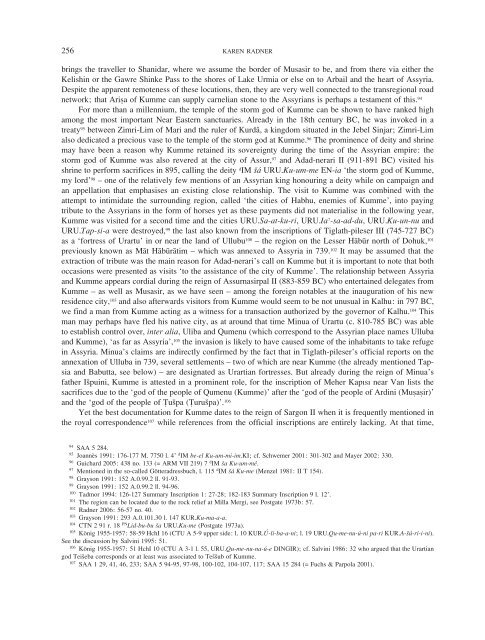Download PDF version of article - UCL
Download PDF version of article - UCL
Download PDF version of article - UCL
Create successful ePaper yourself
Turn your PDF publications into a flip-book with our unique Google optimized e-Paper software.
256 KAREN RADNER<br />
brings the traveller to Shanidar, where we assume the border <strong>of</strong> Musasir to be, and from there via either the<br />
Kelishin or the Gawre Shinke Pass to the shores <strong>of</strong> Lake Urmia or else on to Arbail and the heart <strong>of</strong> Assyria.<br />
Despite the apparent remoteness <strong>of</strong> these locations, then, they are very well connected to the trans regional road<br />
network; that AriÒa <strong>of</strong> Kumme can supply carnelian stone to the Assyrians is perhaps a testament <strong>of</strong> this. 94<br />
For more than a millennium, the temple <strong>of</strong> the storm god <strong>of</strong> Kumme can be shown to have ranked high<br />
among the most important Near Eastern sanctuaries. Already in the 18th century BC, he was invoked in a<br />
treaty 95 between Zimri-Lim <strong>of</strong> Mari and the ruler <strong>of</strong> Kurdâ, a kingdom situated in the Jebel Sinjar; Zimri-Lim<br />
also dedicated a precious vase to the temple <strong>of</strong> the storm god at Kumme. 96 The prominence <strong>of</strong> deity and shrine<br />
may have been a reason why Kumme retained its sovereignty during the time <strong>of</strong> the Assyrian empire: the<br />
storm god <strong>of</strong> Kumme was also revered at the city <strong>of</strong> Assur, 97 and Adad-nerari II (911-891 BC) visited his<br />
shrine to perform sacrifices in 895, calling the deity d IM sá URU.Ku-um-me EN-ia ‘the storm god <strong>of</strong> Kumme,<br />
my lord’ 98 – one <strong>of</strong> the relatively few mentions <strong>of</strong> an Assyrian king honouring a deity while on campaign and<br />
an appellation that emphasises an existing close relationship. The visit to Kumme was combined with the<br />
attempt to intimidate the surrounding region, called ‘the cities <strong>of</strong> Habhu, enemies <strong>of</strong> Kumme’, into paying<br />
tribute to the Assyrians in the form <strong>of</strong> horses yet as these payments did not materialise in the following year,<br />
Kumme was visited for a second time and the cities URU.Sa-at-ku-ri, URU.Ia ? -sa-ad-du, URU.Ku-un-nu and<br />
URU.Tap-si-a were destroyed, 99 the last also known from the inscriptions <strong>of</strong> Tiglath-pileser III (745-727 BC)<br />
as a ‘fortress <strong>of</strong> Urartu’ in or near the land <strong>of</strong> Ullubu 100 – the region on the Lesser Habur north <strong>of</strong> Dohuk, 101<br />
previously known as Mat Haburatim – which was annexed to Assyria in 739. 102 It may be assumed that the<br />
extraction <strong>of</strong> tribute was the main reason for Adad-nerari’s call on Kumme but it is important to note that both<br />
occasions were presented as visits ‘to the assistance <strong>of</strong> the city <strong>of</strong> Kumme’. The relationship between Assyria<br />
and Kumme appears cordial during the reign <strong>of</strong> Assurnasirpal II (883-859 BC) who entertained delegates from<br />
Kumme – as well as Musasir, as we have seen – among the foreign notables at the inauguration <strong>of</strong> his new<br />
residence city, 103 and also afterwards visitors from Kumme would seem to be not unusual in Kalhu: in 797 BC,<br />
we find a man from Kumme acting as a witness for a transaction authorized by the governor <strong>of</strong> Kalhu. 104 This<br />
man may perhaps have fled his native city, as at around that time Minua <strong>of</strong> Urartu (c. 810-785 BC) was able<br />
to establish control over, inter alia, Uliba and Qumenu (which correspond to the Assyrian place names Ulluba<br />
and Kumme), ‘as far as Assyria’, 105 the invasion is likely to have caused some <strong>of</strong> the inhabitants to take refuge<br />
in Assyria. Minua’s claims are indirectly confirmed by the fact that in Tiglath-pileser’s <strong>of</strong>ficial reports on the<br />
annexation <strong>of</strong> Ulluba in 739, several settlements – two <strong>of</strong> which are near Kumme (the already mentioned Tapsia<br />
and Babutta, see below) – are designated as Urartian fortresses. But already during the reign <strong>of</strong> Minua’s<br />
father Ispuini, Kumme is attested in a prominent role, for the inscription <strong>of</strong> Meher Kapısı near Van lists the<br />
sacrifices due to the ‘god <strong>of</strong> the people <strong>of</strong> Qumenu (Kumme)’ after the ‘god <strong>of</strong> the people <strong>of</strong> Ardini (MuÒaÒir)’<br />
and the ‘god <strong>of</strong> the people <strong>of</strong> uspa (uruspa)’. 106<br />
Yet the best documentation for Kumme dates to the reign <strong>of</strong> Sargon II when it is frequently mentioned in<br />
the royal correspondence 107 while references from the <strong>of</strong>ficial inscriptions are entirely lacking. At that time,<br />
94 SAA 5 284.<br />
95 d Joannès 1991: 176-177 M. 7750 l. 4’ IM be-el Ku-um-mi-im.KI; cf. Schwemer 2001: 301-302 and Mayer 2002: 330.<br />
96 d Guichard 2005: 438 no. 133 (= ARM VII 219) 7 IM sa Ku-um-mé.<br />
97 d Mentioned in the so-called Götteradressbuch, l. 115 IM sá Ku-me (Menzel 1981: II T 154).<br />
98 Grayson 1991: 152 A.0.99.2 ll. 91-93.<br />
99 Grayson 1991: 152 A.0.99.2 ll. 94-96.<br />
100 Tadmor 1994: 126-127 Summary Inscription 1: 27-28; 182-183 Summary Inscription 9 l. 12’.<br />
101 The region can be located due to the rock relief at Milla Mergi, see Postgate 1973b: 57.<br />
102 Radner 2006: 56-57 no. 40.<br />
103 Grayson 1991: 293 A.0.101.30 l. 147 KUR.Ku-ma-a-a.<br />
104 PN CTN 2 91 r. 18 Lid-bu-bu sa URU.Ku-me (Postgate 1973a).<br />
105 König 1955-1957: 58-59 HchI 16 (CTU A 5-9 upper side: l. 10 KUR.Ú-li-ba-a-ni; l. 19 URU.Qu-me-nu-ú-ni pa-ri KUR.A-sú-ri-i-ni).<br />
See the discussion by Salvini 1995: 51.<br />
106 König 1955-1957: 51 HchI 10 (CTU A 3-1 l. 55, URU.Qu-me-nu-na-ú-e DINGIR); cf. Salvini 1986: 32 who argued that the Urartian<br />
god Teiseba corresponds or at least was associated to Tessub <strong>of</strong> Kumme.<br />
107 SAA 1 29, 41, 46, 233; SAA 5 94-95, 97-98, 100-102, 104-107, 117; SAA 15 284 (= Fuchs & Parpola 2001).

















